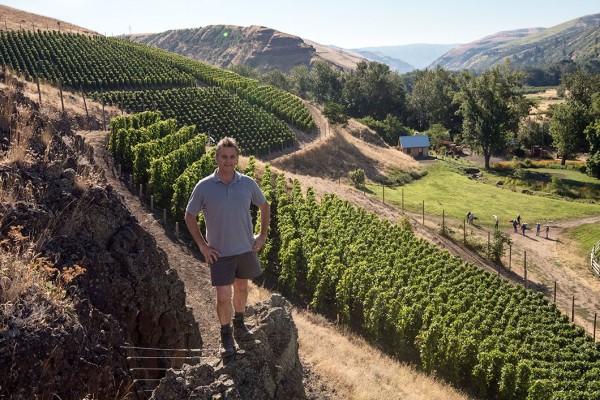
Christophe Baron, Hors Catégorie Vineyard © Andréa Johnson Photography
“I’ve reached the pinnacle of my career in America,” says Christophe Baron.
Baron, founder and vigneron at Bionic Wines, which includes Cayuse Vineyards, No Girls, Horsepower Vineyards, Hors Catégorie Vineyard, and Champagne Christophe Baron, is speaking of Hors Catégorie Vineyard. The site is located in Walla Walla Valley where the North Fork converges with the Walla Walla River. It is among the most spectacularly beautiful vineyards in the Pacific Northwest. It also exemplifies everything about Baron’s approach as a vigneron.
Baron purchased the land in 2005. His now-iconic Cayuse Vineyards was not yet even 10 years old. Baron would not plant the site until 2011 – a full six years later. The first wine wouldn’t be released until 2017.
“Don’t rush me,” Baron says. “Everything I do, it takes time.”
Hors Catégorie
The reason everything takes time is Baron’s methodical – some might say maniacal – approach. Everything is thought through. Every detail is important when one is trying to make wines of the highest possible quality. Make no mistake, Baron is always trying to do things at the highest level.
When Baron first saw the North Fork property, he was reminded of the Northern Rhône. Everything about the vineyard is extreme. The gradient on the hillside where the vines are planted can be up to 60 degrees. The soils are shallow, made of fractured basalt.
Vines are planted at an astonishingly high 3,555 vines per acre. They are staked 3.5 feet by 3.5 feet apart – extremely high density. To call planting this site difficult would be an absurd understatement.
“I told Trevor [Dorland, Cayuse general manager] ‘Stop showing me the bills. Otherwise I will never be able to enjoy it,’” Baron once told me of planting the site.
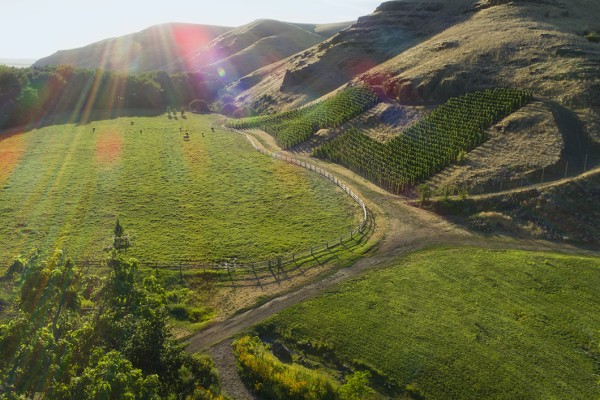
Hors Catégorie Vineyard © Andréa Johnson Photography
While terracing the vineyard would have made it considerably easier to farm, Baron did not. Instead, he decided to leave the site as is and plow the soil using a winch attached to a truck at the top of the hill. Why? He wanted to respect the land and thought it would make better wine.
Hors Catégorie Vineyard is a mere 2.5 planted acres. As with all of the Bionic Wines vineyards, it is farmed biodynamically. There are farm animals on-site that play a critical role in Baron’s holistic approach to winegrowing.
The first released vintage was made in 2014. The site makes a single, eponymous Syrah, with the name a French racing term meaning “beyond categorization.”
Taking one sip of the 2020 Hors Catégorie Syrah, the most recently released vintage, the name of the vineyard immediately seems appropriate. The wine is dense, intense, and structured. It’s also clear why Baron feels that this vineyard is his defining piece of art, “haute couture winemaking” as he once said to me.
Hors Catégorie produces among the finest expressions of Syrah found anywhere on the planet. The 2020 vintage is nothing short of the best wine I have ever had.
“There’s nothing else I can do,” Baron says. “This vineyard is so special. The wines are so unique.”
The Bionic Frog
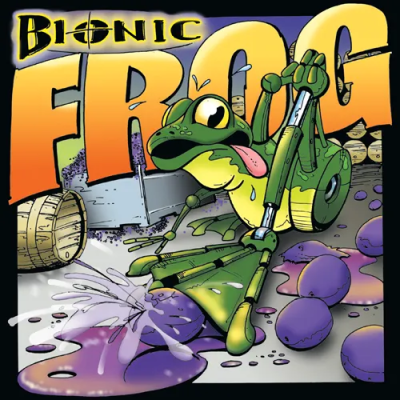 Of course, this doesn’t necessarily mean that Baron will stop trying to do other things. Early on in his career, Baron travelled to Australia, where he was given the nickname Bionic Frog. (He subsequently created a wine at Cayuse of the same name.) It’s easy to understand how he earned the moniker. Born in Château-Thierry in the Champagne region of France, Baron is a blur of energy, a bundle of unbridled passion that he exudes at every moment.
Of course, this doesn’t necessarily mean that Baron will stop trying to do other things. Early on in his career, Baron travelled to Australia, where he was given the nickname Bionic Frog. (He subsequently created a wine at Cayuse of the same name.) It’s easy to understand how he earned the moniker. Born in Château-Thierry in the Champagne region of France, Baron is a blur of energy, a bundle of unbridled passion that he exudes at every moment.
It was this passion that drove Baron to plant his first vineyard in Walla Walla Valley. The story is well-known but remarkable to think that it happened just over 25 years ago – a blip for someone from a family of vignerons that date back to 1677.
Baron had been looking for vineyard land in Willamette Valley when he stopped to see a friend in Walla Walla. Baron showed his friend a book that contained a picture of Châteauneuf-du-Pape’s famed stony soils. The friend told him such an area existed in Walla Walla Valley.
“This is it!” Baron recalls thinking upon seeing the area. His long search for the perfect site was over. In 1997, Baron planted his first vineyard in the region. He would subsequently plant nine more vineyards in Walla Walla Valley for Cayuse and other projects.
The area, which Baron refers to as the Stones, is strewn with cobblestone soils that are the remnant of an ancient riverbed. Planting requires crowbars to wedge the vines between the stones.
The results are wines that not only can be of stratospheric quality but also possess a quality that only the world’s greatest wine regions have. They are singularly unique.
Most people – let’s be honest, truly everyone – would have stopped there, or at least paused for a brief moment. Instead, Baron purchased the Hors Catégorie property and then spent years thinking about how to plant and farm it.
Wines at the edge
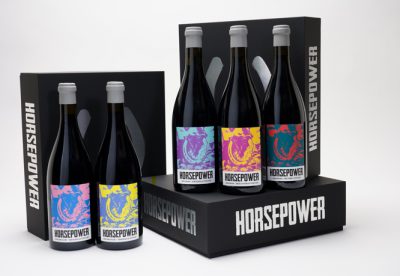 While he was thinking about that, Baron was in the midst of another project, Horsepower Vineyards. All of the vineyards are also in the Stones. The vine rows are planted at such high density and are so tightly spaced that they can only be ploughed by draft horse. The first wines came from the 2011 vintage.
While he was thinking about that, Baron was in the midst of another project, Horsepower Vineyards. All of the vineyards are also in the Stones. The vine rows are planted at such high density and are so tightly spaced that they can only be ploughed by draft horse. The first wines came from the 2011 vintage.
Today, Horsepower has 18 acres planted in 4 vineyards along with 5 draft horses and 3 teams to care for them. Still, Baron continues to make small refinements.
With the 2020 vintage, the Horsepower labels changed from a black and white image of a horse hoof above stony ground to the same image but with bright colors, as if the original label were seen through the eyes of Andy Warhol. The change helps provide easy discernment between the wines, while adding a vibrant dash of color more aligned with Baron’s personality.
Ever-playful with a twinkle in his eye, Baron says that it was the horses that wanted the change. “The horses were upset,” he says. “They said, ‘Cayuse, No Girls, Hors Catégorie, they all have joyful, colorful labels. All we have is gray, black, and white.’”
Baron also recently added a gigantic, 2,000 pound bronze horseshoe at the end of one of the Horsepower vineyards. It was made by a local foundry in Walla Walla and is said to be the largest horseshoe in the world.
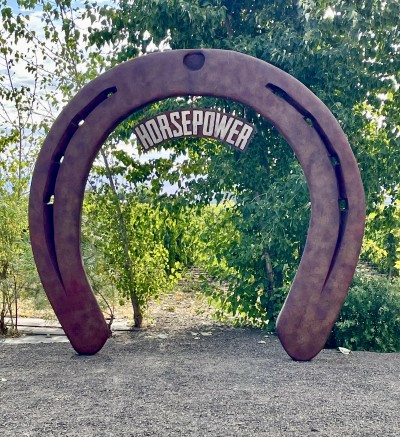
Horsepower Vineyards © Richard Duval
Looking at the sculpture, it serves as both artwork and subtle advertising. Visitor’s to Rôtie Cellar’s tasting room can’t help but see the giant horseshoe across the street. It is also a guaranteed Instagram photo for visitors to the region.
“You go there, and you’re gonna have to rub the horseshoe for good luck,” Baron says.
All of the Horsepower wines are consistently extraordinary – with the 2020 vintage wines reviewed below among the best to date. The High Contrast Syrah, however, consistently stands out as truly unlike any other in the Bionic Wines portfolio.
The vineyard sits at the very edge of the ancient riverbed. It is where the stones end and plain, old windblown silt that is ubiquitous in the area begins.
“You’ve got the positive impact from the stones in terms of terroir – the umami, smoky character and so on – but you also have more fruit,” Baron notes. “I think maybe the best of this area could be all around the edge.”
High Contrast is currently 3.5 planted acres, but the vineyard land itself is 18-acres total. Baron intends to plant a small amount of additional acreage, but it will be planted differently, not at high density, and farmed with traditional tractors.
Feeling doubly lucky
 While across the Bionic Wines portfolio, the wines have years-long waiting lists and are some of the most cultish bottles on the planet, Baron continues to experiment and evolve.
While across the Bionic Wines portfolio, the wines have years-long waiting lists and are some of the most cultish bottles on the planet, Baron continues to experiment and evolve.
The 2024 Cayuse releases will include three wines made only in magnum. Two are comprised of Cabernet Franc, an underappreciated variety in this area. The third is a blend of three vintages of Grenache from 2014, 2015, and 2016. The latter was inspired by Baron’s love of wines from Châteauneuf’s Henri Bonneau. This led him to try extended barrel aging with Grenache.
“We need to have fun. We need to experiment,” Baron says.
Baron also doesn’t assume that all of the success the estate has had to date will be forever granted. For this reason, at least in part, the estate added the Double Lucky wine to the No Girls lineup starting in 2018.
Double Lucky is the most widely distributed offering in the Bionic Wines portfolio. It is also modestly priced at $55. Baron’s hope is that the wine will be a more accessible entry point for millennials and others.
“If I were to describe Double Lucky, it would be ‘Young people, young people, young people,’” Baron says.
In a moment that for Northwest wine lovers was the vinous equivalent to Taylor Swift’s unexpected release of Folklore in 2020 – a life preserver in the midst of the stormiest of pandemic seas – Baron virtually released the inaugural Double Lucky wine in the spring of 2021.
As the estate couldn’t open its doors for its annual release party, Baron sent a free bottle of Double Lucky to everyone on his mailing list. He then conducted a discussion of the wine with list members on Zoom. It was, then and now, an incredibly touching act of generosity.
“It’s not only about business,” Baron says. “Generosity is very, very important. My customers, I would not be where I am without them. I am a very lucky man, being able to wake up in the morning and never drag myself out of bed. How lucky is that?”
Looking back to France
“I never sit on my laurels. We don’t at Cayuse,” Baron says.
In fact, it sometimes seems like perhaps Baron never sits at all. In addition to all of his other projects, Baron started Champagne Christophe Baron in 2014. Fruit for the wines comes from vineyards that originally belonged to Baron’s parents in France’s Marne Valley.
Like everything Baron does, these sparkling wines are a mixture of exceptionally high quality and iconoclastic. The wines are made exclusively from Pinot Meunier, often thought of as the “other” grape of Champagne, though it is the traditional grape of the Marne Valley. The wines are only offered in magnum.
There are four wines, each with fruit coming from vines within approximately a five-mile radius of each other. All of the sites are at the western edge of the Champagne AOC. Vines for three of the sites were planted in 1967, 1968, and 1969.
“Those are the young vines,” Baron says. The oldest fruit, which goes to the Les Clouseaux wine, comes from 1925 plantings.
Baron spends extensive amounts of time in his home country each year, in part working on this project. As we spoke, he was there talking with his cousins about replanting a small number of vines, equating vineyards to a village where there always needs to be newborns.
Vine age
“I told my team ‘This is it! I don’t want to plant anymore!’” Baron says. “They are always rolling their eyes.”
Indeed, the estate will plant two additional acres of Cabernet Sauvignon in 2024. The Cayuse Vineyards Widowmaker Cabernet Sauvignon is made at a scant 300 cases. Over the course of time, as vines mature, the additional plantings might allow that production to expand.
Baron also intends to plant several more acres of Grenache. While Syrah has always received most of the attention from this area, the Grenache can be just as compelling if not more so in the best vintages.
A love of Grenache is also part of what keeps Baron so firmly planted in Walla Walla Valley. In a time when many local winemakers are increasingly drawn by the opportunity to make Pinot Noir from Willamette Valley, Baron is not.
“Grenache is my Pinot Noir,” he says. “So why do I need to go over there?”
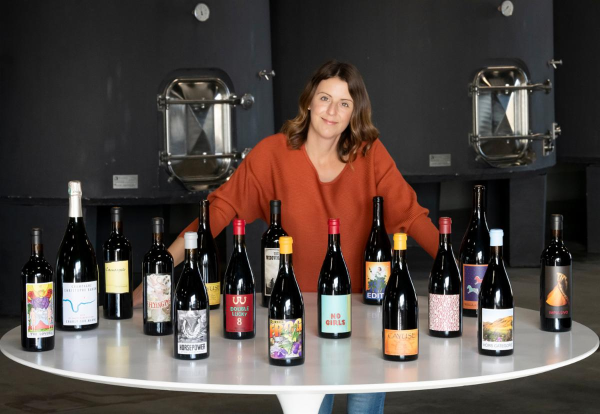
Resident vigneronne Elizabeth Bourcier © Andréa Johnson Photography
While Baron frequently says he will soon be done planting, perhaps this time there might be more reasons to believe him. When I spoke with Baron, it was a few weeks before his 53rd birthday. By his own admission, everything he does takes a significant amount of time.
“We’re gonna plant next year. That means probably for six or seven years, no wines are going to be released [from those vines]. I’m gonna be 60,” Baron says. “I’ve got enough.”
In a sign of transition at the estate, in 2021 Baron promoted assistant vigneronne Elizabeth Bourcier to resident vigneronne. Bourcier joined the team in 2008 and took wines that were already beyond extraordinary and somehow helped elevate them. Prior to taking the lead on the entire portfolio, Bourcier oversaw the No Girls wines. Baron says that promoting Bourcier was rewarding her hard work and loyalty, though he remains intimately involved.
“Let’s put it this way. It’s not easy to work with me,” he says. “I can be intense.”
With Bourcier, however, Baron found something of a kindred spirit with a similar, unerring focus on quality. Baron notes Bourcier’s exceptional palate, management skills, and listening abilities. He says she also brings something unique to the table.
“Elizabeth never gives up,” Baron says. “The blend is done. The wine is perfect, and she always says ‘Let’s do another trial of that best blend, but maybe with 30 gallons of that wine from that tank.’”
What’s next for Bionic Wines?
With Bourcier now as resident vigneronne and Hors Catégorie as Baron’s viticultural and vinous masterpiece, might Baron truly be done pushing boundaries?
Don’t believe it for a moment. It’s not in his nature. Even if he were, the seeds that Baron has planted in the Northwest will continue to grow at Bionic Wines and beyond.
When Baron first planted in the Stones in 1997, the idea seemed so crazy that some literally referred to him as “the crazy French guy.” Today there are over 500 acres planted in this region of the valley, and in 2015 it received appellation status as the Rocks District of Milton-Freewater. (Baron continues to label his wines Walla Walla Valley.)
Whereas before, the Cayuse Vineyards wine studio stood alone in this area of the valley, now Rôtie Cellars, Force Majeure, and others are nearby. The area will only continue to grow in the coming years and will increasingly become a tourist destination. (NB: Cayuse Vineyards is not open to the public.)
Similarly, Baron planted a flag in the North Fork region at Hors Catégorie. Other producers are following suit in this area with different projects.
So what might be next for Baron? It could be anything. Baron talks of creating wine experiences, restoring buildings, and other ideas in a fertile mind that never sits still.
One thing is clear, however. Whatever Baron does next, whether it involves planting additional vineyard acreage or not, he will do it slowly. He will also do it at the highest possible level.
“I always look for the best everywhere because mediocrity, it’s easy to be mediocre,” Baron says.
* * *
At Northwest Wine Report, all scores come from blind tastings in varietal/style sets. Read more about this site’s process for rating and reviewing wines. Read about the Northwest Wine Report rating system and special designations. Read about how to interpret scores. See a list of recently reviewed producers.
Note that access to reviews and ratings at Northwest Wine Report now requires a subscription. Wineries submitting wines are under no obligation whatsoever to subscribe and can receive reviews freely after they have been published by contacting [email protected].
Editor’s Note: The wines below were sampled in varietal flights along with others over the last several tasting cycles.


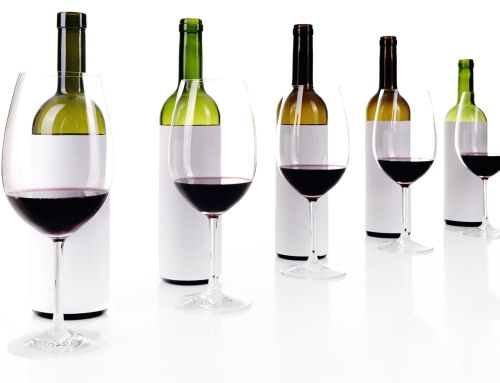
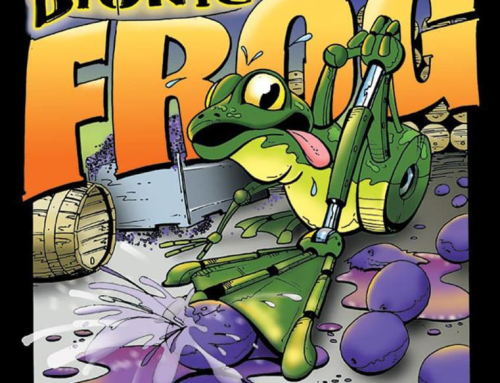

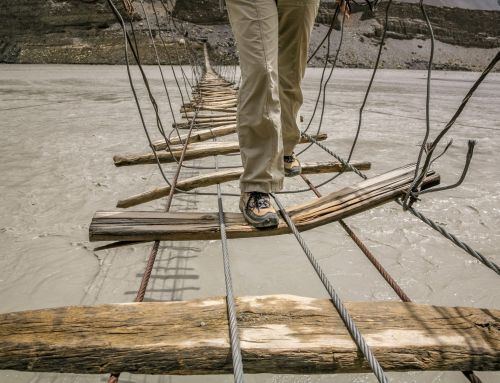

Leave A Comment